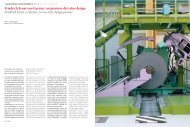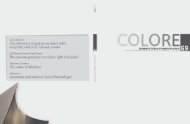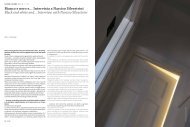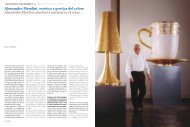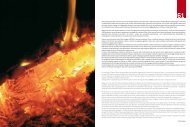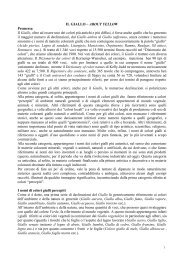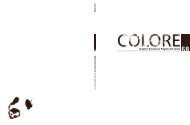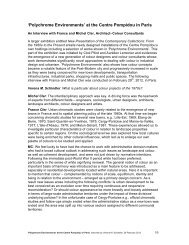CULTURA / CULTURE [(1 + 2) 3 4 5 6 ]Rosso Cina: <strong>intervista</strong> a <strong>Barbara</strong> <strong>Pietrasanta</strong><strong>China</strong> <strong>Red</strong>: an interview with <strong>Barbara</strong> <strong>Pietrasanta</strong>Rosso Cina... / <strong>China</strong> <strong>Red</strong>...di/by: Lia LuzzatoNell'immaginario occidentale la Cina è rossa, rossolacca: un colore e una tecnica che hanno segnatol'opulenza e il fasto delle antiche dinastie.La lacca è un prodotto di origine vegetale è una resinatratta degli alberi della specie Rhus Vernicifera,diffusa in tutto l'Oriente, che devono avere almeno10 anni di vita prima di poter essere intagliatiper essere incisi e estrarre il loro succo lattiginosoil cui colore poteva essere modificato, per raggiungerela tonalità gradita, con l'aggiunta di ossidi diferro e in seguito di pigmenti o con la sovrapposizionedi strati di colore diverso per riuscire ad ottenerela tonalità desiderata. Il procedimento prevedevainoltre, tra un passaggio, e l'altro uno stratodi lacca trasparente e una levigatura perfetta perpoter ottenere un rosso ricco e profondo.Un coloree una tecnica raffinata e delicata, sviluppatasi durantela dinastia Han (206 a.C) e che ha attraversatoi secoli raggiungendo apici di grande splendoresotto la dinastia Ming (1368-1644) dove il rossodelle lacche viene addirittura scolpito e cesellatocon foglie d'oro, incrostato di madreperla e di pagliuzzed'argento.“Il rosso lacca è il colore simbolo della dinastia Han,quella che diede il nome alla popolazione etnica cinese,il colore dei suoi vasi di terracotta e delle suedivise militari” scrive <strong>Barbara</strong> <strong>Pietrasanta</strong> nel libro“L'Ideogramma al Neon” dove racconta la sua esperienzaprofessionale, estetica e di vita nella Magnificaterra di mezzo.Artista e direttore creativo dell'agenzia pubblicitariaAnyway, da lei stessa fondata alla fine degli anni'80, è docente da diversi anni alla ZhongGuanVocational Training School di Shanghai dove intraprendeprogetti di formazione sulla comunicazionevisiva.Dalla prime pagine del suo libro viene incontro unasuperficie completamente rossa con un sinogrammabianco al centro, una lucente tonalità pantoneche suggerisce la prima domanda.For the Western imaginary <strong>China</strong> is red, lacquer red:a colour and a technique that marked the opulenceand splendour of the ancient dynasties.Lacquer is a product of vegetal origin, being a resinextracted from the trees of Rhus Vernicifera, commonin all the Orient and that need to grow for atleast 10 years before it is possible to carve themin order to extract their milky juice, the colour ofwhich could be modified, to obtain the requiredhue, by the addition of iron oxides and subsequentlypigments or by overlapping layers of differentcolours in order to attain the desired tone. This processalso contemplated, between each step, a layerof transparent lacquer and a perfect smoothingin order to attain a rich and deep red. These refinedand subtle techniques for an equally precious colour,were developed during the Han dynasty (206B.C) and trough the centuries have reached peaksof great splendour under the Ming dynasty (1368-1644) where the red of lacquers was even sculptedand chiselled with golden leaves, encrusted withmother-of-pearl and silver particles.“Lacquer red is the symbol of the Han dynasty, theone that gave name to the whole Chinese ethnicpopulation, the colour of their earthen vases andtheir military uniforms” writes <strong>Barbara</strong> <strong>Pietrasanta</strong>in the book “L'Ideogramma al Neon” [The Neon Ideogram]where she tells her professional, aestheticand life experience in the magnificent Central Kingdom.Artist and creative director of the advertisingagency Anyway, founded by her at the end of theEighties, she teaches since several years at theZhongGuan Vocational Training School of Shanghaiwhere she carries on formative projects on visualcommunication.From the first pages of the book the first thing thatcatches the eye is a completely red surface with awhite ideogram in the middle, a shiny pantone tonethat suggests our first question.A cosa si deve la scelta di questo rosso?E' assolutamente il colore che colpisce di più quandosi entra in contatto con l'ambiente urbano Orientale.Il rosso è dappertutto, nei templi, nelle locande,nell'arredamento, nelle lanterne, negli abiti,nelle insegne, nelle città, con gradazioni diverse:un rosso lucido che vira al porpora per i templi lacui sacralità è sottolineata anche dall'uso dell'oro;un rosso quasi pompeiano per le mura della CittàProibita di Pechino i cui meravigliosi padiglioni sideclinano in tonalità dal rosso all'arancio; un rossoche si avvicina al magenta per l'abito da sposatradizionale; un rosso vivo di riminiscenza rivoluzionariaper le grandi pubblicità stampa e per tuttoil materiale editoriale : testate, i titoli, ambientazionidelle foto. Il rosso in Cina è un fil rouge tra latradizione e la contemporaneità. Il bianco del sinogramma,che significa “felicità,” è stato invece unascelta estetica e di leggibilità, esso proviene da unsigillo che in Cina dovrebbe essere rigorosamentedi inchiostro rosso.What is there behind the choice of such a red?It is undoubtedly the most striking colour whenone first gets in touch with the Oriental urban environment.<strong>Red</strong> is everywhere, in the temples, in thetaverns, in the furniture, in the lanterns, in the clothes,in the shop signs, in the cities, with differentgradations: a glossy red that almost turns purplefor the temples, whose sacred nature is also underlinedby the use of gold; an almost Pompeian redfor the walls of the Forbidden City of Beijing, whosemagnificent pavilions’ shades vary from red toorange; an almost magenta red for the traditionalwedding dress; a vivid red that is reminiscent of therevolution for the huge press advertisings and morein general for all the publishing material: headlines,titles, pictures’ settings. <strong>Red</strong> in <strong>China</strong> is a sort ofcommon thread that links tradition and contemporaneity.The white used for the ideogram, that means“happiness”, has instead been chosen for its appearanceand legibility, and it comes from a seal that in<strong>China</strong> should strictly be made of red ink.18 COLORECOLORE19
CULTURA / CULTURE [1 2 (3 + 4) 5 6 ]Rosso Cina... / <strong>China</strong> <strong>Red</strong>...Un colore così presente e invasivo deve esserelatore di messaggi, simboli e tradizioni importanti,diffusi in tutto il paese.Assolutamente, pare addirittura che, contrariamenteall'Occidente, questo colore non abbia nella suasimbologia alcun riferimento negativo. In particolareil rosso-arancio è associato alla buona sorte, allaterra, alla vitalità. Nella simbologia del Tao è il coloreche rappresenta il ritorno ciclico dello Yang, dopo ilsolstizio d'inverno e le sfumature più aranciate sonoespresse da un sinogramma che oltre al coloreesprime il concetto di: “pregare per avere fortuna” .Inoltre, come per noi, il Capodanno viene festeggiatoall'insegna del rosso e ai bambini si regalano bustedi questo colore contenenti delle banconote. Laparola “Chi” che indica il rosso cinabro, trasmetteanche i significati di cordialità e di sincerità, di lealtàe di coraggio.Il rosso ha attraversato epoche molto diverse traloro per valori e ideologia senza perdere la suaforza comunicativa ed emozionale anche oggi dovetutto è globalizzato.Sì il colore rosso resiste e si è inserito in tutti i linguaggiodierni, dall'arte alle più svariate forme dicomunicazione. Non è più solo il colore della propagandacomunista, ma il vestito di una nuova generazioneche sta cercando una propria identità e collocazionein un universo di valori cambiato.L'artista Li Shan, in “Rosso fiore” un'opera del1995, ripropone un giovane Mao su una grandecampitura rossa come quella dei dazibao della propagandamaoista. Il leader è presentato con un fiorein bianco bocca e ha un aspetto effeminato: unarivisitazione dell'immagine in chiave pop, forse peresorcizzarla. <strong>Del</strong> resto questo colore è stato usatoa piene mani nell'immagine coordinata delle Olimpiadidi Pechino: la realizzazione che ha coronatoil debutto di questo popolo sul palcoscenico del villaggioglobale. Una rappresentazione visuale forte,ricca di valenze simboliche poggiata sulla forzadel rosso. Questo colore- simbolo che ha incarnatosperanze e ideali cinesi, attraversando inalterato isecoli e le epoche storiche, era presente ovunquenegli inviti, nei programmi, negli stendardi, spessoaccostato al giallo: un richiamo alle stelle gialle dellabandiera.Anche il simbolo delle olimpiadi, il pittogramma innegativo su fondo rosso, di un atleta in movimento,richiamava i timbri rossi, utilizzati come sigillodi autenticità sui documenti ufficiali e sui dipinti.Such a present and invasive colour should bearimportant messages, symbols and traditions, popularall over the country.For sure it is, it even seems that here, unlike theWest, this colour has in its symbology no negativereference. <strong>Red</strong>-orange in particular is related to goodluck, to the earth, to vitality. In the Tao symbologyit is the colour representing the cyclic returnof Yang, after the winter solstice and the most orangeyshades are expressed by an ideogram that meansnot just the colour name but also the concept:“praying to get luck”. In addition, as it happens forus, the New Year is celebrated under the sign of redand red envelopes containing banknotes are givento children. The word “Chi”, that means cinnabarred, conveys also the meanings of friendlinessand sincerity, loyalty and courage.<strong>Red</strong> has travelled trough many epochs, differentfor values and ideologies, without losing its communicativeand emotional power, even now wheneverything goes global.Yes, the red colour resists and it is inside every contemporarylanguage, from art to the most variousforms of communication. It is no longer just the colourof communist propaganda, but the dress codeof a new generation that is looking for an identityand a place in a universe of changed values. The artistLi Shan, in “Flower <strong>Red</strong>” a work of 1995, reproducesyoung Mao against a huge red backgroundsimilar to the wall posters of the Maoist propaganda.The dictator is represented having a flower inthe mouth and it has an effeminate look: a pop-likereinterpretation of the image, maybe with an exorcizingintent. After all this colour was abundantlyused for the coordinated image of the Beijing OlympicGames: the achievement that has fulfilled thedebut of this country on the centre stage of the globalvillage. A strong visual representation, rich insymbolic values based on the strength of red. Thiscolour-symbol that has embodied hopes and idealsof Chinese people, travelling unchanged troughthe centuries and the historical periods, waseverywhere on invitation cards, on programs, onbanners, often mated to yellow: a clear reference tothe stars of the national flag. Also the symbol of theOlympic Games, the negative image of a pictogramon red background, representing a moving athlete,reminded the red stamps, used as authenticity sealsfor official documents and for paintings.Anche in Cina la pubblicità può manipolare le reazioniemotive e psicologiche di una persona versoun prodotto usando un particolare colore.Sì, la CocaCola non ne ha avuto bisogno, non ha dovutoadattare nulla, il colore del suo marchio era giàrosso! Ed è sempre presente sulla tavola delle famigliecinesi moderne. Se si chiede a un cinese cosabeve durante i pasti risponderà: Ke-kou-ke-le: sorsodi gioia!Per altri prodotti invece è indispensabile puntare suun colore diverso, soprattutto per i prodotti cosmeticidove il bianco si lega inestricabilmente all'idealedi bellezza femminile come nel passato. In uncelebre romanzo dell'epoca Ming la protagonista hala trecce folte nere e la pelle nivea. Così per le viedelle grandi città campeggiano volti di donne occidentalio orientali con la pelle bianchissima. Perchéle aziende occidentali che vogliono presentarsisul mercato devono avere una linea essenzialmente“white”.La Cina e i suoi colori come hanno inciso sul rapportocon il suo lavoro e la sua arte?Anche la Cina contemporanea è uno sfavillio di colorie appena entriamo nell’ambiente urbano ci colpisconole tinte forti, i contrasti per noi inusuali, azzardatie a volte stridenti. E’ però proprio la graficadelle insegne e dei cartelloni pubblicitari che colpiscecon i loro ideogrammi che campeggiano e saltanoagli occhi ricordandoci la loro valenza che vaoltre la parola ma è storia e immagine, perché il sinogrammaci racconta molto di quello che è rappre-In <strong>China</strong> too advertising can manipulate the emotiveand psychological reactions of a person towardsa product just by using a particular colour.Yes, Coca Cola did not need that, it had to changenothing, the colour of its brand was already red!And it is always present on the tables of modernChinese families. If someone asks to a Chinesewhat he drinks at mealtime, he will answer: Ke-kouke-le:a sip of joy!For other products it is instead necessary to usea different colour, especially for cosmetics, wherewhite is always inextricably connected to the idealof feminine beauty, as in the past. In a famous novelof the Ming period the female protagonist hasthick black plaits and ivory skin. That is why thestreets of big cities are decked by the visages oforiental as well as western women showing a perfectlywhite skin. So the western firms that want toenter the national market have to display an essentially“white” image.How have <strong>China</strong> and its colours influenced the relationshipwith your work and your art?Even contemporary <strong>China</strong> is a tinsel of coloursand when we enter the urban environment, we arestruck by the strong hues, the contrasts unusualfor us, daring and sometimes jarring. However it isthe graphics of signs and street advertising thatmostly strike with their ideograms that stand outand catch the eye reminding us of their value thatgoes beyond words being instead history and image,because they tell much of what is represented20 COLORECOLORE21



